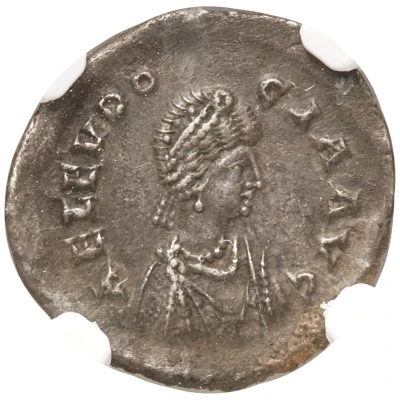


© Heritage Auctions
Siliqua - Aelia Pulcheria Cross within wreath; Constantinopolis
| Silver | 1.51 g | 18 mm |
| Issuer | Eastern Roman Empire (Rome) |
|---|---|
| Regent | Pulcheria (Πουλχερία) (414-421) |
| Type | Standard circulation coin |
| Years | 420-429 |
| Value | 1 Siliqua (1⁄24) |
| Currency | Solidus (330-476) |
| Composition | Silver |
| Weight | 1.51 g |
| Diameter | 18 mm |
| Shape | Round (irregular) |
| Technique | Hammered |
| Orientation | Variable alignment ↺ |
| Demonetized | Yes |
| Updated | 2024-10-10 |
| Numista | N#373234 |
|---|---|
| Rarity index | 100% |
Reverse
Cross within wreath terminating in large jewel; mintmark in exergue.
Script: Latin
Lettering: CONS
Comment
Aelia Pulcheria was an Eastern Roman empress who advised her brother emperor Theodosius II during his minority and then became wife to emperor Marcian from November 450 to her death in 453.She was the second child of Eastern Roman Emperor Arcadius and Empress Aelia Eudoxia. In 414, the fifteen-year old Pulcheria became the guardian of her younger brother Theodosius II.
When Theodosius was killed in a riding accident in AD 450, Pulcheria briefly ruled as sole empress before bowing to demands that she marry and thus chose a suitable man to rule as Augustus.
Variants are known, under this reference along with other references, given the types of ties of the wreath on reverse:
From RIC Volume 10
Interesting fact
The Aelia Pulcheria silver siliqua, minted during the reign of Emperor Theodosius II (420-429 AD), features a unique design that sets it apart from other coins of the Eastern Roman Empire. On the obverse side, the coin bears the image of a cross within a wreath, surrounded by the legend "CONSTANTINOPOLIS" in Greek. This design was a departure from the traditional imagery of Roman emperors and was meant to emphasize the Christian faith of the ruling dynasty. The coin's reverse side features the empress Aelia Pulcheria, wife of Theodosius II, with the inscription "AELia PULCHERIA AUGUSTA" (Augusta being the title given to the empress). This coin is a rare example of a Byzantine coin that highlights the influence of Christianity on the empire's currency during this period.



